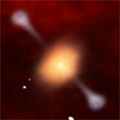CXC Home | Search | Help | Image Use Policy | Latest Images | Privacy | Accessibility | Glossary | Q&A

Animation of How Supermassive Black Holes Affect the Formation of Massive Galaxies
QuickTime MPEG This animation begins by looking at the exterior of an elliptical galaxy. It then zooms into the region near the galaxy's massive central black hole. The sequence then shows how powerful jets of high-energy particles emanate from the vicinity of the black hole. These jets heat gas around the galaxy and stop the infall of matter into the galaxy, thereby limiting the galaxy's growth. This is what astronomers believe is happening in the cases of 4C41.17 and 3C294.
[Run time = 0:20 sec]
(Animation: CXC/A.Hobart)
See Animation Stills
QuickTime MPEG This animation begins by looking at the exterior of an elliptical galaxy. It then zooms into the region near the galaxy's massive central black hole. The sequence then shows how powerful jets of high-energy particles emanate from the vicinity of the black hole. These jets heat gas around the galaxy and stop the infall of matter into the galaxy, thereby limiting the galaxy's growth. This is what astronomers believe is happening in the cases of 4C41.17 and 3C294.
[Run time = 0:20 sec]
(Animation: CXC/A.Hobart)
See Animation Stills

Interview with Caleb Scharf (Columbia University)
Caleb Scharf of the Columbia Astrophysical Laboratory led the team that used Chandra to study 4C41.17. He talks about the significance of his team's findings and how they reveal clues into the history of galaxies.
[Total running time = 3:53 sec]
(Credit: NASA/CXC)
Part 1 |
Part 2 |
Part 3 |
Part 4 |
||
QuickTime |
|||||
Mpeg |
|||||
Caleb Scharf of the Columbia Astrophysical Laboratory led the team that used Chandra to study 4C41.17. He talks about the significance of his team's findings and how they reveal clues into the history of galaxies.
[Total running time = 3:53 sec]
(Credit: NASA/CXC)

Interview with Andrew Fabian (Cambridge University, UK)
Andy Fabian speaks about his group's research on the formation of massive galaxies through their long Chandra observation of 3C294. In this interview, he explains why such studies are important and exciting to the astronomical community.
[Total running time = 1:56 sec]
(Credit: NASA/CXC)
Part 1 |
Part 2 |
Part 3 |
||
QuickTime |
||||
Mpeg |
||||
Andy Fabian speaks about his group's research on the formation of massive galaxies through their long Chandra observation of 3C294. In this interview, he explains why such studies are important and exciting to the astronomical community.
[Total running time = 1:56 sec]
(Credit: NASA/CXC)
Return to 4C41.17 and 3C294 (21 May 03)


